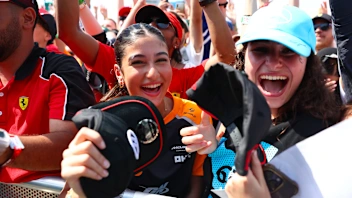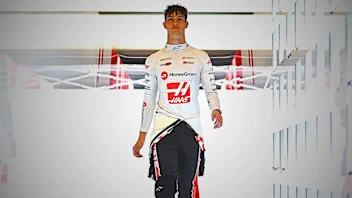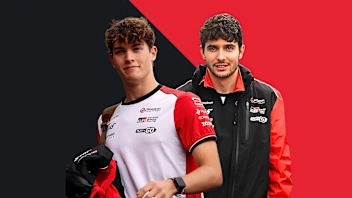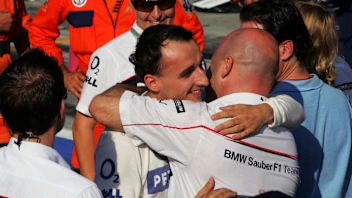Ricciardo excluded from Australia race results
Red Bull’s Daniel Ricciardo has lost his second-place finish in Sunday's Australian Grand Prix after stewards decided his car had run with too high a fuel flow rate during the race. The team are to appeal the decision.
Ricciardo crossed the line behind winner Nico Rosberg to claim his maiden F1 podium. His exclusion elevates McLaren's Kevin Magnussen to P2 and team mate Jenson Button to third.
Under article 5.1.4 of the new 2014 technical regulations, cars are limited to a fuel flow rate of 100kg/hour, as measured by an FIA-homologated sensor on the car.
According to the stewards’ report, Red Bull used a different fuel sensor on Saturday after they found the one used on Friday had produced unreliable readings. However, when the sensor used on Saturday failed to provide results that were satisfactory to them or the FIA, they were instructed to change back to the original sensor within parc ferme on Saturday night.
Considering this sensor unreliable, Red Bull chose to rely on their own internal fuel flow model, something that the stewards say is in violation of the procedure outlined in the technical regulations.
Furthermore, Red Bull were warned by the FIA’s technical representative during the race that the fuel flow on Ricciardo’s car was too high. The team were given the opportunity to correct this, but according to the stewards’ report, they chose not to make any changes.
Announcing their intention to appeal the stewards’ decision, Red Bull said: “Inconsistencies with the FIA fuel flow meter have been prevalent all weekend up and down the pit lane. The Team and Renault are confident the fuel supplied to the engine is in full compliance with the regulations.”
The stewards' decision in full:
The Stewards, having received a report from the Technical Delegate, heard from the team representatives, have considered the following matter and determine a breach of the regulations has been committed by the competitor named below and impose the penalty referred to.
No/Driver: 3, Daniel Ricciardo
Competitor: Infiniti Red Bull Racing
Time: 20:17
Session: Race
Facts: Car #3 was not in compliance with article 5.1.4 of the FIA Formula 1 technical tegulations.
Offence: Breach of article 3.2 of the FIA Formula 1 sporting regulations and Article 5.1.4 of the FIA Formula 1 technical regulations.
Decision: Car #3 is excluded from the race results.
Reason:
1) The technical delegate reported to the stewards that car #3 exceeded the required fuel mass flow of 100kg/h. (article 5.1.4 of the Formula 1 technical regulations)
2) This parameter is outside of the control of the driver, Daniel Ricciardo.
3) The fuel flow is measured using the fuel flow sensor (Art. 5.10.3 & 5.10.4 of the technical regulations) which is homologated by the FIA and owned and operated by the team.
4) The stewards considered the history of the fitted fuel flow sensor, as described by the team and the technical delegate's representative who administers the programme. Their description of the history of the sensor matches.
a. During practice one a difference in reading between the first three and run four was detected. The same readings as Run 4 were observed throughout practice two.
b. The team used a different sensor on Saturday but did not get readings that were satisfactory to them or the FIA, so they were instructed to change the sensor within parc ferme on Saturday night.
c. They operated the original sensor during the race, which provided the same readings as run four of practice one, and practice two.
5) The stewards heard from the technical representative that when the sensor was installed on Saturday night, he instructed the team to apply an offset to their fuel flow such that the fuel flow would have been legal. He presented an email to the stewards that verified his instruction.
6) The technical representative stated to the stewards that there is variation in the sensors. However, the sensors fall within a known range, and are individually calibrated. They then become the standard which the teams must use for their fuel flow.
7) The team stated that based on the difference observed between the two readings in P1, they considered the fuel flow sensor to be unreliable. Therefore, for the start of the race they chose to use their internal fuel flow model, rather than the values provided by the sensor, with the required offset.
8) Technical directive 01614 (1 March 2014) provides the methodology by which the sensor will be used, and, should the sensor fail, the method by which the alternate model could be used.
a. The technical directive starts by stating: "The homologated fuel flow sensor will be the primary measurement of the fuel flow and will be used to check compliance with articles 5.1.4 and 5.1.5 of the F1 technical regulations..." This is in conformity with articles 5.10.3 and 5.10.4 of the technical regulations.
b. The technical directive goes on to state: "If at any time WE consider that the sensor has an issue which has not been detected by the system WE will communicate this to the team concerned and switch to a back-up system."
(emphasis added.)
c. The back-up system is the calculated fuel flow model with a correction factor decided by the FIA.
9) The FIA technical representative observed thought the telemetry during the race that the fuel flow was too high and contacted the team, giving them the opportunity to follow his previous instruction, and reduce the fuel flow such that it was within the limit, as measured by the homologated sensor - and thus gave the team the opportunity to be within compliance. The team chose not to make this correction.
10) Under Art. 3.2 of the sporting regulations it is the duty of the team to ensure compliance with the technical regulations throughout the event.
Thus the stewards find that:
A) The team chose to run the car using their fuel flow model, without direction from the FIA. This is a violation of the procedure within TD/01614.
B) That although the sensor showed a difference in readings between runs in P1, it remains the homologated and required sensor against which the team is obliged to measure their fuel flow, unless given permission by the FIA to do otherwise.
C) The stewards were satisfied by the explanation of the technical representative that by making an adjustment as instructed, the team could have run within the allowable fuel flow.
D) That regardless of the team's assertion that the sensor was fault, it is not within their discretion to run a different fuel flow measurement method without the permission of the FIA.
The stewards find that car #3 was out of compliance with the technical regulations and is therefore excluded from the results of the race.
Next Up
Related Articles
.webp) End Of Year Reports 2025Kick Sauber’s best and worst moments from 2025
End Of Year Reports 2025Kick Sauber’s best and worst moments from 2025 Formula 1’s record-breaking 2025 season in numbers
Formula 1’s record-breaking 2025 season in numbers ExclusiveHow Bearman went from super-sub to star rookie in 2025
ExclusiveHow Bearman went from super-sub to star rookie in 2025 End Of Year Reports 2025Haas’ best and worst moments from 2025
End Of Year Reports 2025Haas’ best and worst moments from 2025 Albon names moment he's most proud of from 2025
Albon names moment he's most proud of from 2025 Sauber’s best moments and most memorable liveries in F1
Sauber’s best moments and most memorable liveries in F1